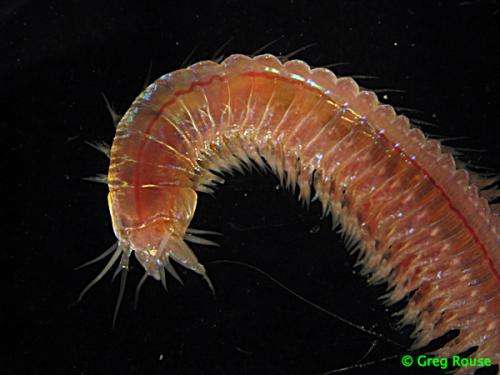Dawn of carnivores explains animal boom in distant past

(Phys.org) —A science team that includes researchers from Scripps Institution of Oceanography at UC San Diego has linked increasing oxygen levels and the rise and evolution of carnivores (meat eaters) as the force behind a broad explosion of animal species and body structures millions of years ago.
Led by Erik Sperling of Harvard University, the scientists analyzed how low oxygen zones in modern oceans limit the abundance and types of carnivores to help lead them to the cause of the "Cambrian radiation," a historic proliferation of animals 500-540 million years ago that resulted in the animal diversity seen today. The study is published in the July 29 early online edition of the Proceedings of the National Academy of Sciences.
Although the cause of the influx of oxygen remains a matter a scientific controversy, Sperling called the Cambrian radiation that followed "the most significant evolutionary event in the history of animals."
"During the Cambrian period essentially every major animal body plan—from arthropods to mollusks to chordates, the phylum to which humans belong—appeared in the fossil record," said Sperling, who is scheduled to join Scripps as a postdoctoral researcher through National Science Foundation support. The authors linked this proliferation of life to the evolution of carnivorous feeding modes, which require higher oxygen concentrations. Once oxygen increased, animals started consuming other animals, stimulating the Cambrian radiation through an escalatory predator-prey "arms race."
Lisa Levin, a professor of biological oceanography at Scripps, along with graduate student researcher Christina Frieder, contributed to the study by providing expertise on the fauna of the ocean's low-oxygen zones, areas that have been increasing in recent decades due to a variety of factors. While the Cambrian radiation exploded with new species and diversification, Levin believes this study suggests the reverse may ensue as oxygen declines and oxygen minimum zones expand.
"This paper uses modern oxygen gradients and their effects on marine worms to understand past evolutionary events" said Levin, director of Scripps's Center for Marine Biodiversity and Conservation and a 1982 Scripps graduate. "However, the study of oxygen's role in the past is also going to help us understand the effects of and manage for changes in ocean oxygen in the future."
More information: Oxygen, ecology, and the Cambrian radiation of animals, www.pnas.org/cgi/doi/10.1073/pnas.1312778110
Journal information: Proceedings of the National Academy of Sciences
Provided by University of California - San Diego
















